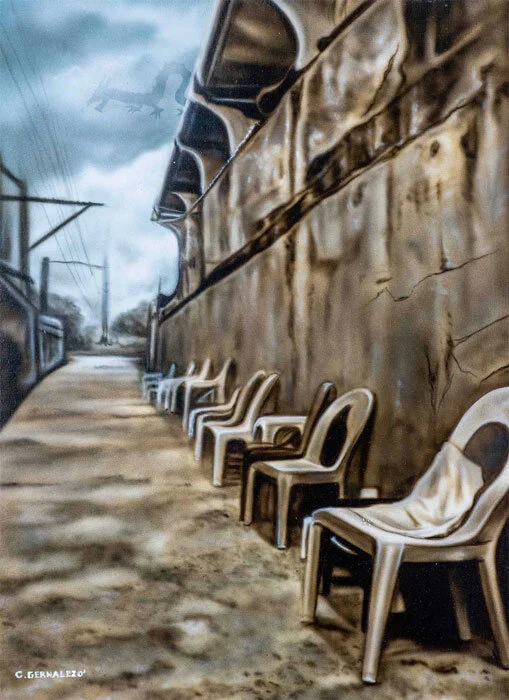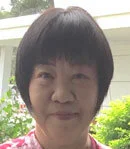Ateneo Art Gallery at 60: Art Amidst Disruption
/Areté Ateneo Panorama, 2018. Image by Ryomaandres, CC by SA 4.0, via Wikimedia Commons.
In 2018, it moved to a new space in Areté, the four-storey creative hub and art complex of the Ateneo de Manila University. With seven new galleries, it can now display some 30 percent of its permanent collection at one time.
Inaugural Exhibits in Areté
In Areté, one of its inaugural exhibits was Love It and Leave It: A Legacy of Gifts to the Ateneo Art Gallery, where AAG honors the generosity of its donors (Ateneo alumni and artists) through the years with their names listed on gallery walls.
The Wilson L. Sy Prints and Drawings Gallery saw its first retrospective survey, Elmer Borlongan Draws the Line that includes works on paper in pencil, charcoal, pen and ink, and watercolor from the 1970s to the present, including studies for paintings or final works. AAG describes Borlongan as one of the leading contemporary artists today.
Elmer Borlongan Draws the Line Exhibit. Ateneo Art Gallery. Image by R.C. Ladrido.
Another exhibit was The ‘70s: Objects, Photographs, and Documents, a nod to the 1970s, which saw "the rise of conceptual art practice which encouraged artists to explore innovative forms and approaches," with guest curator Ringo Bonoan who concentrated on photography and installation art.
AAG Exhibition Program
Boots Herrera, AAG director and chief curator, explains that its exhibition program is based on its permanent collection, which is strong on the postwar period. It is also based on a specific period or on a specific artist, seen in retrospectives, such as Agnes Arellano (2019), Alfredo Esquillo (2018), Lee Aguinaldo (2010), or the drawings and works on paper by Charlie Co (2020) and Elmer Borlongan (2018).
The World According to Charlie Co, 2020. Ateneo Art Gallery. Image by R.C. Ladrido.
Some exhibits from its permanent collection of prints also include Print[ed]: The Print Folio: Selections from the AAG Collection in August 2018 and The AAG Print Collection Revisited in May 2019.
History
The Ateneo Art Gallery was founded in 1960 with Fernando Zobél's (1924-1984) donation of his Philippine modern art collection, as well as fine prints and drawings of international artists, to the Ateneo from 1959 to 1964 where he taught humanities and art appreciation.
As detailed by art historian Patrick Flores, the donation consisted of "67 paintings, 127 prints, 25 drawings, and 2 sculptures from Abdulmari Imao" who would be declared a National Artist for Sculpture in 2006, a total of 221 items. In this lot, 18 works are Zobel's.
Inside the Ateneo Art Gallery, 2018. Image by Ryomaandres, CC by SA 4.0, via Wikimedia Commons.
Flores also added that the strength of AAG's collection is neorealism, with "the early works of such stalwarts as Hernando R. Ocampo, Vicente Manansala, Cesar Legaspi, Romeo Tabuena, and Victor Oteyza." With Zobel's donation, the Ateneo Art gallery became the first modern art museum in the Philippines.
Emmanuel Torres, who was selected by Zobél himself as the museum's first curator, wrote about Zobél's donation in 1983:
"...his intention was to set up a small art gallery - the first of its kind in the country - as a component of the university's humanities program. It was also meant as a museum the public could visit and see a substantial body of works signifying the best of modern Philippine art."
Caloy Gernale, A Quarantine View, 2020. Marciano Galang Acquisition Prizes, Ateneo Art Gallery Collection.
Under Torres, the collection expanded considerably with key works by early and postwar modernists such as Galo Ocampo, Nena Saguil, and Diosdado Lorenzo.
Torres also had the astute sense to support artists known as social realists, who emerged during the regime of Ferdinand Marcos, such as Renato Habulan, Edgar Talusan Fernandez, Antipas Delotavo, Pablo Baens Santos, Leonilo Doloricon, and Jose Tence Ruiz, among many others.
Today, AAG has an extensive collection of Philippine social realist art of the 1970s and the 1980s that was shown in an exhibit, Ligalig: The Role of Art in a Time of Turmoil in 2017 "to underscore the role of art as a critique of the prevailing social and political order."
In addition, AAG is also the first museum in the country to include video art in its permanent collection in 2011. In an exhibition, Modes of Impact: The Inaugural Collection of Video Art in 2012, the museum launched nine video art works as its initial acquisition. Included are Kiri Dalena, Erased Slogans (2008); Manny Montelibano, Ma'am Said (2006); Maria Taniguchi, Untitled (Universal Motors (2012); and Gerardo Tan, Mirror Painting (2002-2012).
Through the years, many other benefactors and art patrons have followed Zobél's lead, so that the AAG collection now surveys every Philippine art movement in the postwar era, "from neo-realism and abstract expressionism to today's post-modern hybrid tendencies."
Out of the White Cube
Beyond its university constituents, AAG has been reaching out to a wider public through its public programs and activities such as the Ateneo Art Awards, ArtSpeak, publications, lectures, and workshops, with some offered for children in summer.
Since AAG's early days, lecture-type events on art making have always been held. Today, ArtSpeak has evolved into a series of discussions with artists (usually those who have had an exhibition in AAG) on their practices.
With Covid-19, ArtSpeak has gone online since July 2020 with its first guest, Agnes Arellano, who describes in detail how she makes her sculptures based on her own body.
Started in 2004, the Ateneo Art Awards with its Fernando Zobél Prizes for Visual Art is given every year to young artists under the age of 36 whose works were exhibited the previous year. Museum and gallery directors, artists, and art educators residing in the Philippines nominate artists for this award.
“Amidst the closure of museums since March 2020, Boots Herrera has called for exploring “more collaborative programs among local museums.””
Some winners include Archie Oclos (2019) for Lupang Hinirang in the 2018 Thirteen Artists Awards, Cultural Center of the Philippines; Johanna Helmuth (2018) for Makeshift, Blanc Gallery; and Cian Dayrit (2017), Exposition, Lopez Museum and Library.
The winners receive an international art residency grant funded by AAG and its partner institutions: La Trobe University in Bendigo, Australia; Artesan Gallery+ Studio in Singapore; and Liverpool Hope University in the United Kingdom.
As part of the Ateneo Art Awards, the Purita Kalaw Ledesma Prizes in Art Criticism has been given since 2014. Kalaw-Ledesma (1914-2005) was an artist, writer, and founder of the Art Association of the Philippines in 1948, the longest running art organization in the country.
AAG and its partner, the Kalaw-Ledesma Foundation, aim "to put art criticism in the public sphere.” Since 2016, two winners have been chosen who will contribute to Art Asia Pacific or The Philippine Star.
AAG Outdoors
Through its Ignacio B. Gimenez Outdoor Installation Grant Program, AAG funds two outdoor installation projects a year. Its first one for 2019, Everywhere, There You Are by Ling Quisumbing Ramilo and Wawi Navarroza, is a seemingly moving wave of orange, an art installation of neon-orange fabric strips cut and tied to a fishing net.
Its second outdoor installation was Inscapes:A Retrospective by Agnes Arellano that displays her sculptures from 1983 to 1996, retracing her life through works with themes of the sacred feminine, Eros, yin and yang, and mythology.
Inscapes: A Retrospective by Agnes Arellano, 2020. AAG Outdoor Installation. Image by R.C. Ladrido.
AAG-MGAP: A New Acquisition Program
As its immediate response to the Covid-19 crisis, AAG has cancelled the Ateneo Art Awards 2020 and in its place has instituted a new acquisition program (Ateneo Art Gallery-Marciano Galang Acquisition Prize Program), with support from the Embassy of Italy, Manila, to help Filipino artists.
The program honors Marciano Galang (1945-2001) of Cabusao, Camarines Sur whose Cavite (1964), an oil on canvas with an assemblage of discarded objects – can, shoes, and burlap– was the first work acquired through Fernando Zobél's Purchase Fund, conceived in 1965.
Marciano Galang, Cavite, 1964. Ateneo Art Gallery Collection.
Celebrating its 60th anniversary, AAG announced 54 works out of a total of 329 entries in August 2020 that have been selected for the AAG-MGAP online exhibition until May 2021.
Of the 54 works, AAG has acquired 15 works for its permanent collection; the Embassy of Italy has purchased two works for its own Philippine contemporary art collection.
Amidst the closure of museums since March 2020, Boots Herrera has called for exploring "more collaborative programs among local museums." Under the new normal, she also underscores the need "to aggressively develop and equip ourselves with more digital tools and modes" in order "to maximize use of museum's collection and rich archives."
Rosa Concepcion Ladrido is a freelance copy editor and writer in Manila on art, culture, and food history of the Philippines and beyond. She has done research on Iloilo's traditional breads and bakeries.










